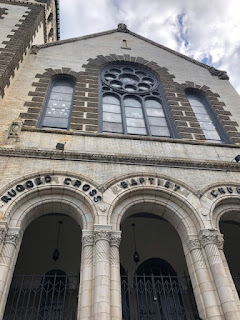Every year from 1940 until 1942 and 1947 until 2019, the Tour of Sommerville--"the Kentucky Derby of cycling"--was held on Memorial Day. That day, on the fourth Monday of May, is called "the unofficial beginning of Summer in the United States.
For many, today--Labor Day--is the unofficial end of the season. The following day, most people have returned to work. (Grim but interesting fact: Mohammed Atta, the "mastermind" of 9/11, chose that date because it fell on the Tuesday following Labor Day, when he figured almost everybody would be on their jobs--and thus provide more potential victims.) So, I suppose it's appropriate that the Tour of Somerville, after being cancelled altogether last year, was re-scheduled to this date.
Near the race course stands a monument to Furman Kugler, who won the event's first two editions. Encased in Plexiglas is a photo of him next to the bike he rode--a Shelby Classic. Interestingly, it bears more semblance to a track than a criterium bike of its time, with its wooden rims and fixed gear. According to Tom Avenia, it was de rigeur at the time. I'd take his word on that: He rode in several editions of the Tour--on a fixed gear, during the 1950s and early 1960s.
Perhaps more to the point, neither Kugler nor Carl Anderson, who won in 1942, would return when the Tour resumed: Both lost their lives while fighting in World War II.
Perhaps the monument to Kugler would be more fitting on Memorial Day. But at least it's there, and the Tour is running again this year.











